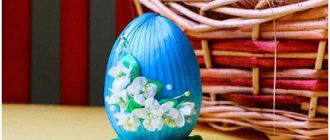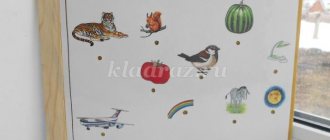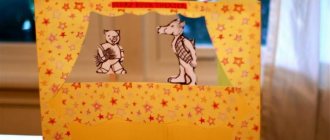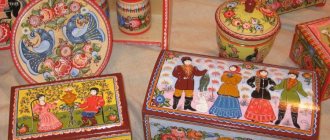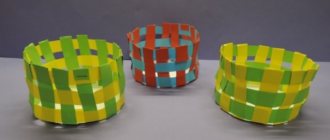Pedagogical project “Theater of Plastic Spoons”
Pedagogical project
"Theater of Plastic Spoons"
Educator:
–
teacher 1st quarter categories.
Project topic: Preparing characters for dramatization of a Russian folk tale
"Teremok" for showing a puppet theater made from disposable plastic spoons.
Author of the project: – teacher 1st quarter. categories
Project type: children's, short-term
Project participants: teacher, senior children, parents of students.
Relevance of the topic:
The most popular and exciting area in preschool education is theatrical activities. From the point of view of pedagogical attractiveness, we can talk about the versatility, playful nature and social orientation, as well as the correctional capabilities of the theater.
It is theatrical activities that make it possible to solve many pedagogical problems related to the formation of the expressiveness of a child’s speech, intellectual and artistic-aesthetic education. By participating in theatrical games, children become participants in various events from the lives of people, animals, and plants, which gives them the opportunity to better understand the world around them. At the same time, theatrical play instills in the child a sustainable interest in his native culture, literature, and theater.
The educational value of theatrical games is also enormous. Children develop a respectful attitude towards each other. They learn the joy associated with overcoming communication difficulties and self-doubt. Children’s enthusiasm for theatrical play, their inner comfort, relaxedness, easy, non-authoritarian communication between an adult and a child, the “I can’t do it” complex disappears almost immediately - all this surprises and attracts.
Fairy tales serve as the first lesson for children about morality and ethics by which people live. This sets the child up for an optimistic perception of life, develops positive character traits and social behavior skills. Work on the theatricalization of a fairy tale contributes to the development and correction of all mental cognitive processes. Learning the words of a fairy tale helps develop memory, expand vocabulary, automate sound pronunciation, and expressiveness of speech. Thus, work on the theatricalization of fairy tales contributes not only to the replenishment of knowledge and skills, but is a means of developing general gaming skills, speech, personal qualities of the child, and his adequate behavior in various situations.
Goal: to prepare the necessary equipment and material for the staging of the Russian folk tale “Teremok”
Tasks:
- To promote the development of dialogic and monologue speech, to develop the ability to pronounce words clearly and clearly, and to develop intonation expressiveness. Develop the ability to imitate the characteristic actions of characters. Involve parents in family reading of Russian folk tales and help in the creation of characters and attributes for fairy tales.
Project implementation stages.
Preparatory stage.
- Exhibition of books of Russian folk tales in the book center. Selection of visual teaching aids and illustrations for fairy tales. Acquisition of the necessary equipment and material for the creation of the Russian folk tale “Teremok”.
Main stage.
- Reading a fairy tale with parents at home and with the teacher in kindergarten. Listening to a fairy tale in an audio recording; viewing the video. Retelling a fairy tale using a tabletop theater Manual labor - making fairy tale characters with children and parents from scrap material (plastic spoons)
The final stage.
- Showing the Russian folk tale "Teremok" for children of other groups. Conversation with children (What happened? What did you like? etc.) Conversations with parents and their feedback on the children’s show of the staged puppet fairy tale “Teremok”
“Development of event content with parents”
Master class “Do-it-yourself spoon theater”
Form of delivery: master class.
Audience: middle school parents.
Tasks:
1. Increase the pedagogical competence of parents in matters of education and development of preschool children.
2. To develop skills of interaction with a child at different stages of his development.
3. Contribute to increasing the effectiveness of interaction between parents and preschool educational institutions.
4. To form parents’ ideas about the importance of theatrical activities for the comprehensive development of the child.
5. Learn to make riding dolls from spoons.
Expected results:
• increasing the pedagogical competence of parents in matters of education and development of preschool children.
• developing skills to interact with a child at different stages of his development.
• increasing the effectiveness of interaction between parents and preschool educational institutions.
• formation of parents' ideas about the importance of theatrical activities for the comprehensive development of the child.
• making riding dolls from spoons for the fairy tale “Zayushkina’s hut”.
Information and technical support: projector, tape recorder.
Materials and equipment: 7 unpainted wooden spoons; acrylic paints; brushes; textile; braid; pieces of fur; animal caps for the dramatization of the fairy tale “Teremok”; puppets for different types of theater.
Logic of implementation.
1. Game with a parachute “Dash”.
Goal: promote group cohesion. (Annex 1) .
2. Message from the teacher “The importance of theatrical activities for the comprehensive development of the child.”
Goal: to form parents’ ideas about the importance of theatrical activities for the comprehensive development of the child.
(Appendix 2) .
3. Survey of parents “What types of theater do you know?”
Goal: to identify parents’ ideas about types of theater.
(Appendix 3) .
4. Message from the music director “Types of theater in kindergarten” followed by a show of puppets.
Goal: to introduce parents to the types of puppet theater in kindergarten. (Appendix 4) .
5. Master class on making dolls from wooden spoons.
Goal: learn to make riding dolls from spoons. (Appendix 5) .
6. Parents dramatize the fairy tale “Teremok” with musical accompaniment.
7. Summing up. Final message from the teacher.
(Appendix 6) .
Annex 1.
Game with a parachute "Dash".
Goal: promote group cohesion.
Progress of the game: parents stand holding the colored sector. They raise and lower the parachute with the words: “We’re tired of standing, we need to run across!” »
At the leader’s signal: “1, 2, 3 – blue (any other color) run! "- those who stand in the sector of the named color run across under a parachute and change places.
Appendix 2.
The importance of theatrical activities for the comprehensive development of a child.
In modern society, the social prestige of intelligence and scientific knowledge has increased. Associated with this is the desire to give children knowledge, teach them to read, write and count, but little attention is paid to the ability to feel, think and create.
In addition, recently children have been fascinated by computers and other newfangled toys, with which parents are trying to replace their peers, protecting the child from troubles, from “bad influences”; adults are also trying to fill the lack of children’s community, help and participation of adults in the development of the child, Without this, full mental and emotional development of the individual is impossible.
The shortest path to a child’s emotional liberation, relief from constriction in learning, feeling and artistic imagination is the path through play, fantasy, and writing.
The solution to these problems is theatrical activity.
The importance of theatrical activities in the development of a child can hardly be overestimated, since theatrical art occupies a special position among other types of arts due to the possibility of a direct emotional impact on a person.
According to researchers (, , and others, theatrical activities allow solving many pedagogical problems, especially speech, intellectual, artistic and aesthetic development and education of children; it is an inexhaustible source of development of emotions and feelings, a means of introducing a child to spiritual values, and performs psychotherapeutic function.
Theatrical activity, being a type of game, is initially synthetic in nature: it is a literary text and the sounding word, the plasticity and actions of the actor, his costume and the visual space of the stage (light, color, music, etc.).
Thus, children's theater allows the teacher to solve problems not only of an executive nature, but also cognitive, social, aesthetic, and speech.
Appendix 3.
Parent survey “What types of theater do you know?”
Goal: to identify parents’ ideas about types of theater.
• What types of theaters do you know?
• What types of puppet theater do you know?
• Do you think it is possible to make theatrical puppets at home?
Appendix 4.
Types of theater in kindergarten.
Puppet theater is a magical world - one of the greatest models of Man and Humanity. Unlike drama theatre, where live people play instead of puppets, puppet theater is more durable. Its actors are capable of living for many centuries, and any museum doll, guided by the hand of an experienced puppeteer, at any moment is capable of coming to life and playing in front of us the same puppet comedy that was admired by the audience - kings, artisans, nobles, merchants, hired soldiers - and a hundred and two hundred and four hundred years ago.
There are several classifications of puppet theater games for preschool children:
tabletop puppet theater: theater on a flat picture, on circles, magnetic tabletop, cone, toy theater. (The music director tells an excerpt from the fairy tale “Turnip” using a cone theater).
stand theater: flannelgraph, shadow, magnetic stand, stand-book. (The music director tells an excerpt from the fairy tale “The Tale of the Stupid Mouse” using a flannelgraph).
theater on the hand: finger, pictures on the hand, mitten, glove, shadow. (The music director tells the nursery rhyme “Cockerel, cockerel” using a cockerel mitten).
floor dolls: marionettes, cone theater.
living puppet theater: theater with “living puppets”, life-size puppets, human puppets, mask theater, Tanta Moreschi. (The music director recites A. Barto’s poem “I Love My Horse” using a life-size puppet - a girl).
riding dolls: on gapit, on spoons, bibabo, cane. (The music director tells an excerpt from the fairy tale “Zayushkina’s Hut” using a doll on a spoon).
Appendix 5.
Stages of making dolls from wooden spoons.
1. On the outside of the spoon, draw a person’s face or an animal’s muzzle.
2. Decorate with braid, pieces of fur, and ribbons.
3. Sew a skirt out of fabric and put it on a spoon.
4. Tie the skirt tightly at the “neck” of the spoon.
Appendix 6.
Final message from the teacher.
Dear parents! Today you learned about the importance of theatrical activities for the comprehensive development of a child, got acquainted with types of theater that can be used in joint games with children, and also learned how to make dolls from spoons yourself, and tried yourself as an actor.
We hope that all this will help you spend time together in an interesting and beneficial way for your child’s development.
After all, with the help of playing theatrical games together, you can easily and naturally form the correct model of behavior in the modern world, improve the child’s general culture, introduce him to children’s literature, music, fine arts, etiquette rules, rituals, and traditions. Then the love for the theater will not only become a vivid childhood memory, but will also remain a feeling of celebration from the time spent with you in the unusual magical world of the theater.
We wish you good luck!
Theater! How much he means to a child’s heart, how impatiently children look forward to meeting him! The art of puppet theater is folk in nature.
Dolls can do everything or almost everything. They work wonders: they entertain, teach, develop the creative abilities of preschoolers, and correct their behavior. Children are happy to join in the game: answer the dolls’ questions, fulfill their requests, give advice, and transform into one image or another. They laugh and cry along with the dolls, warn them about dangers, and are always ready to help their heroes. How can you make the joy of communicating with them become daily? We need to create a puppet theater in kindergarten and at home! Children are introduced to puppet theater from the 1st junior group. Educators and older preschoolers show small performances to children, using various types of theaters for this purpose: the well-known picture theater (flannelgraph, parsley theater, in which glove puppets are occupied. With great pleasure, children watch the figures moving on a brightly lit screen. The shadow theater is riveting their attention, develops the ability to concentrate. Theater on the table is the simplest and most accessible theater for all ages of children. The torso of the dolls is made in the form of a cone, to which the doll's head and arms are attached.
By the end of the year, children of the 1st junior group, having accumulated some experience, try to independently participate in a puppet show. This desire must be supported, developed and strengthened. A finger theater is suitable for this purpose.
Mitten dolls were born from ordinary knitted mittens. The imagination of teachers and children can turn the most ordinary mittens into animals and people. They are very easy to operate and are intended for very young children.
For children of the 2nd junior group, the simplest and most accessible theater is a puppet theater on a table. You can use different types: “disc” theater, three-dimensional toys made of cylinders and cones, boxes of different heights. Origami theatre, mug theatre, lollipop theatre, kinder theatre, washcloth theatre, magnet theatre. Glove puppets are very mobile and expressive. Glove puppets can be used as funny assistants in kindergarten classes. Bibabo dolls usually operate on a screen behind which the driver is hidden.
In the middle group we move on to more complex theater. We introduce children to theater screens and cane puppets. These dolls are larger than glove dolls (head size can be up to 20 cm). This doll is raised above the screen with the help of a rod inserted inside, which is called a "gapit". Canes are attached to the doll's hands - sticks, which the puppeteer moves. But before staging a play with these dolls, you need to give children the opportunity to play with them. The Spoon Theater, being a simplified version of the performance with the participation of riding puppets, helps children master puppeteering techniques.
My dolls turned out to be very cute, strong and attractive.
Materials:
A set of spoons, cardboard, any fabric, woolen threads, felt or other material, ribbons and eyes.
Preparation method:
Hair. We use wool threads to make pompoms. They are instantly glued with glue to the inside of the spoon. Thread colors can be completely different. For the grandfather doll, we used a ready-made pompom and a dress from a New Year's hat.
Cloth. It’s better, of course, to sew a dress - a felt cone, then you won’t have to hem it. But you can also use other fabrics, preferably dense, to keep their shape.
We sew the cone together and make a cut in the upper part, just below the corner. We insert a spoon into the cut and tie it tightly with a ribbon, maybe with a bow.
Eyes. You can draw eyes on a spoon, stick on ready-made running eyes, or make an applique.
In my case, it turned out to be such a bright royal family.
Get text
Materials for working with crafts
If you have disposable spoons, forks or any other plastic utensils lying around, you should not keep them until a future picnic or throw them away because they may not be useful. It’s better to sit and think about what you can do with disposable tableware. Simple crafts for kindergarten can become your child’s first masterpiece. And family members certainly won’t be bored with such an activity. In addition, you can keep the product with your own hands and use it as some additional element to the interior or give such a creation to your loved ones on their holiday. All you need is:
In addition to the above examples, you can make other crafts using your imagination. The easiest way is to make flowers from plastic spoons, but if you decide to make your own invented masterpiece, then you won’t have to look for a photo of a sample, and this is already harder. You can make it using ready-made templates, for example, a lake with one swan or a whole family of these wonderful birds. By the way, your imagination can be completely unpredictable, so turn your ideas into reality!
All the characters you see in the photo have one thing in common - they were created using plastic spoons. This one for creativity allows you to work wonders!
Steps for creating ladybugs from disposable spoons
Performing such crafts will certainly be very interesting for children, but some manipulations can only be done with adults.
- All spoons need to have their handles cut off, but it is best to do this after the spoons have been painted and the paint has dried.
- One spoon should be painted black, and two should be painted red. For red spoons you need to add black dots.
- To create the “head” of a ladybug, you need to put 2 white dots on the lid or button.
- We glue the “insect” - two red spoons are glued onto a black spoon in an A-shape - the “wings” of a ladybug.
- Glue a button or lid to the base of the structure. And here we have the cutest craft, which will take no more than 10 minutes to make.
Any craft made from plastic spoons is always attractive for its simplicity and at the same time beauty. No special tools are required for production, and almost every craft can be completed even by the youngest inventors.
You can absolutely not limit your imagination and go beyond the master classes you study, creating unique products. In addition, such crafts can be incredibly useful in everyday life, which makes them especially valuable.
https://youtube.com/watch?v=hMNGw4PaAUs
https://youtube.com/watch?v=VJS1rjKZMxw
Tulips
The easiest way to make tulips. Especially if you are new to such experiments.
You will need:
- Plastic spoons (5 spoons for 1 product);
- Colored paper (corrugated);
- Glue, scissors;
- Green electrical tape;
- Cocktail tube.
Cut equal, even squares of colored paper. Wrap spoons in them and seal them so that they resemble tulip petals. Pre-cut the legs of the spoons.
Even a child can do what is described. Save all children's crafts (even unsuccessful ones) from plastic spoons: over time, you will be curious to track the progress of the little inventor.
Panel of forks
Fans of unusual decorative items will appreciate this craft. The panel looks like a flower, looks stylish and will decorate the interior.
@svoimi-rukami-club.ru
To work you will need:
- disposable forks (from 20 pieces, depending on the planned distance between them);
- old music records or CDs;
- colored cardboard;
- ribbons and lace, beads and artificial flowers for decoration;
- glue gun;
- scissors;
- acrylic paints (optional).
Making a frame is not difficult. The work consists of several stages:
- To see how the panel will look, it is recommended to place the forks around the entire circumference of the plate/disc before work. You can mark with a pencil the places where the forks will be glued. Only after this should you move on.
- The most important and painstaking task is gluing the forks onto the plate. This must be done carefully so as not to smear the glue on the surface of the future craft.
- When the previous stage is completed, you can begin decorating the panel with lace and ribbon. This is not difficult to do: one end of the tape needs to be secured with glue and intertwined with all the forks.
- Then the second plate is applied to the cardboard and traced along its contour. Next, a circle of cardboard is cut out and glued to the plate.
- The resulting blank is decorated as desired. After that, it is glued to the plate with forks.
You can glue an artificial flower or beads to the center of the finished panel, and on the wrong side it is recommended to make a loop from a thin satin ribbon.
Interior decoration
To make these decorations look better, you need to purchase colored devices or paint them only with spray paint. This way there won’t be streaks left on the spoons from the brush. Below are described in detail 2 options that are easy to implement.
Sunflower mirror
This craft is suitable for decorating a kitchen, bathroom or nursery.
What materials and tools are needed:
- small round mirror (10-15 cm in diameter);
- thick cardboard (a box from under household appliances will do);
- pencil;
- scissors;
- glue gun;
- glue Moment;
- yellow and black spray paint;
- 80 white spoons or 16 black and 64 yellow;
- screwdriver.
Crafts from plastic spoons, forks - a mirror in the shape of a sunflower
Step-by-step instruction:
- Draw 2 circles on cardboard: 25-30 cm in diameter and 5-7 cm in diameter. Cut circles with scissors. Determine the center of the large circle and glue the small one to this place, then find the center of the small circle and glue the mirror evenly.
- Paint 16 spoons black and the rest yellow. If the dishes are already painted, then simply cut off all the handles under the base.
- With the concave side up, the black petals need to be glued to the cardboard with a glue gun so that the bases of the spoons fit into the gap under the mirror, which was formed due to the small cardboard circle.
- Glue all the yellow spoons in a circle in a checkerboard pattern so that they cover the gaps between the petals in the previous rows. The bases of each of them should not be visible.
To hang a mirror on the wall, you need to make a hole on the back side with a screwdriver, closer to the center. The cardboard is thicker in this area due to the small circle. Now you can “stick” the mirror onto the nail.
Clock for the kitchen or cafe
For this craft, disposable utensils do not need to be cut or deformed. It is the original shapes that will help you create a kitchen-themed watch.
Crafts from plastic spoons, forks - watches
What you will need:
- a small round watch with a flat frame around the dial;
- A4 office paper;
- compass;
- pencil;
- scissors;
- 10 disposable forks, 10 knives and 10 spoons;
- glue gun;
- a handful of small pasta in the shape of a wheel;
- spray paint.
How to design a watch:
- First of all, you need to protect the dial glass from glue and paint. Using a compass on paper, draw a circle equal to the diameter of the glass. Cut out and apply to the dial.
- Glue cutlery to the frame in a circle, alternating them (fork, knife, spoon).
- Glue the pasta in a circle, separating the handles of the cutlery from the glass.
- Hold a piece of paper and spray paint onto the clock.
It is important that all parts are well coated with paint, so 2 cans may be required
Water lily
What is needed: spoons (twelve pieces), green and transparent plastic bottles, yellow paint, brush, glue, scissors.
How to do:
- cut off the handles of the spoons;
- glue three cut spoons together;
- glue four cut spoons together;
- Glue three glued spoons to four;
- glue five spoons together and glue the previously glued spoons to them;
- from a transparent plastic bottle, cut out a long strip about 2 cm wide, paint it with yellow paint, let it dry, cut the fringe on one side;
- we fold the resulting fringed strip into several circles and secure it with glue, glue what we got into the middle of the previously made water lily;
- cut out a leaf from a green bottle (you can use a transparent bottle painted with green paint);
- glue the water lily to the leaf.
Other options
If your CD is not scratched, then you can not hide it in cardboard and glue it entirely, and then simply decorate it.
You can use satin ribbons more densely, and fill the free space with them in a checkerboard pattern.
By the way, here is another version of the New Year's fan. A typical attribute of this holiday is used - tinsel.
There are colored forks in stores, so if they match the chosen color scheme, feel free to use them.
In general, when it comes to decorating the fan itself, you can use all the techniques you know. For example, very elegant flowers are made from satin ribbons; the method of creation is called kanzashi. If you have the skills to work in this technique, you will find another use for it, and if this is new to you, you will acquire new knowledge.
As you can see, creating the base of the forks is, in principle, simple and monotonous. But decorating the product will allow the craftswoman to demonstrate all her knowledge, skills and imagination. Ribbons, lace, various yarns, beads, beads, rhinestones, feathers and much, much more - everything that is at hand can become part of amazing creations. And believe me, no one can pass by such creativity indifferent.
What to stock up on and where to go next
There are a lot of ideas for making various crafts from plastic spoons. As a rule, most of these products will require basic elements: the spoons themselves, cardboard, glue, sometimes paints or colored paper, scissors.
You can start making crafts without worrying about where to “attach” the craft later - thanks to the convenience of the material itself, any product will be so cute and original that acquaintances, friends and relatives will be happy to receive such a gift.
In addition, such crafts are often used in everyday life, to decorate a house or a summer cottage. On a well-kept lawn or vegetable garden, crafts made as flowers are most often used - this way you can give the plantings a beautiful accent. And for the New Year holidays, plastic spoons will provide limitless scope for creativity.
Separately, it is worth noting those types of crafts that can be functional in nature and useful in the household. Perhaps this is a significant advantage for any craft, because usually the result of creative success does not find a place in the house and is safely forgotten or thrown away.
Palm tree - an exotic garden decoration
A palm tree made from plastic bottles will help add a touch of the tropics to your dacha. Making such a garden decoration item is not difficult, the main thing is to follow the sequence of steps. First you need to prepare the materials: a large number of brown and green plastic bottles, a stationery knife, tape, a tube for decorating the barrel and a thick rope. The master class looks like this step by step:
- Creating leaves.
- Creating a trunk.
- Assembly of all parts of the structure.
To make a palm tree crown, you need to cut off the bottom of green bottles, and cut the upper part into small strips and bend them in the other direction. There is no need to touch the lid and neck. Depending on the number of bottles, the palm will be thicker or vice versa. After this, you need to take brown bottles, cut off the bottom and make stripes from it towards the neck. There should also be a lot of bottles. To assemble the tree, a rope is tied to each lid, secured inside. The palm tree will serve as an excellent decoration for an inconspicuous corner on the site.
